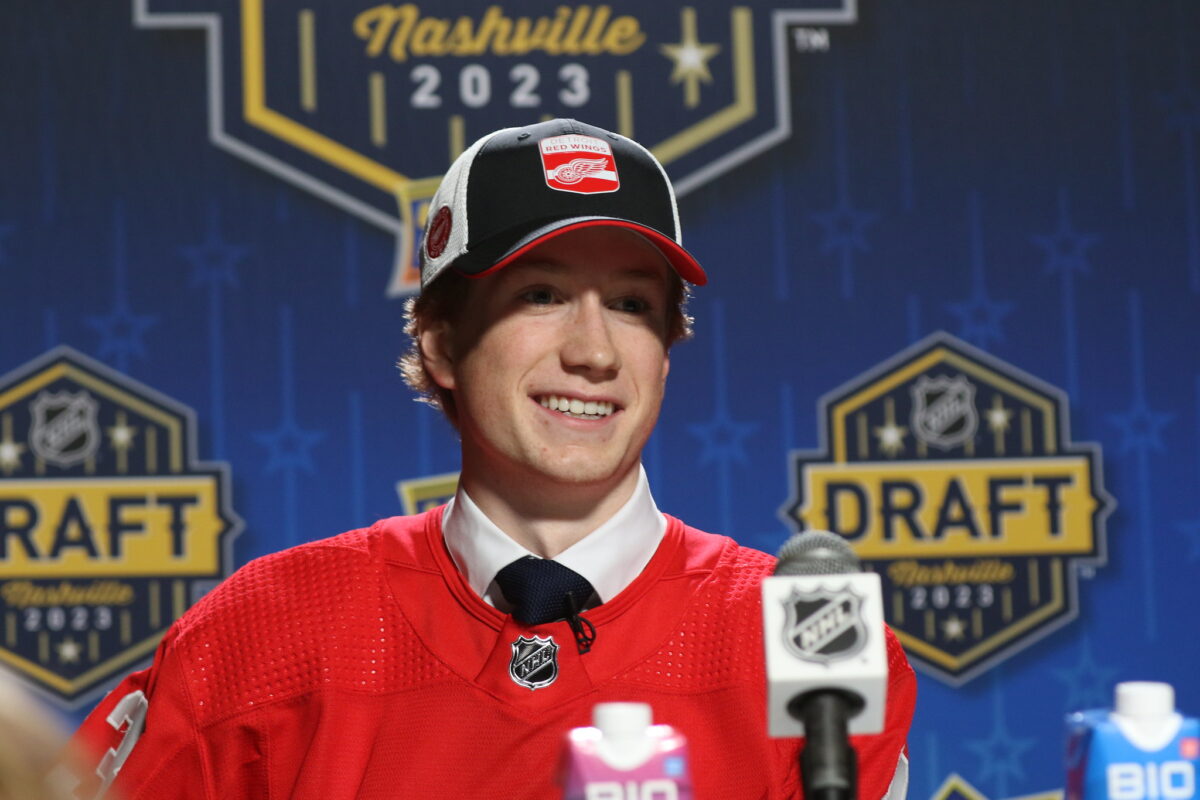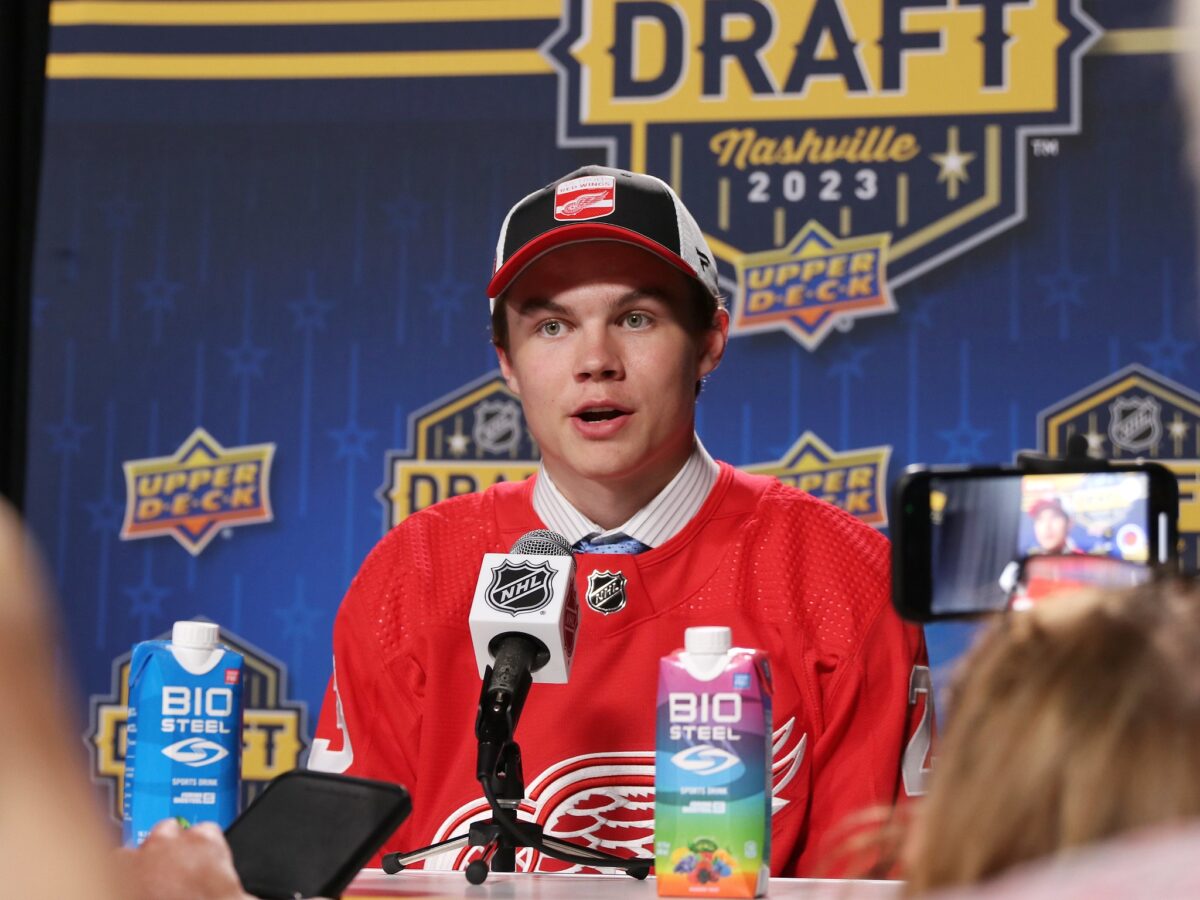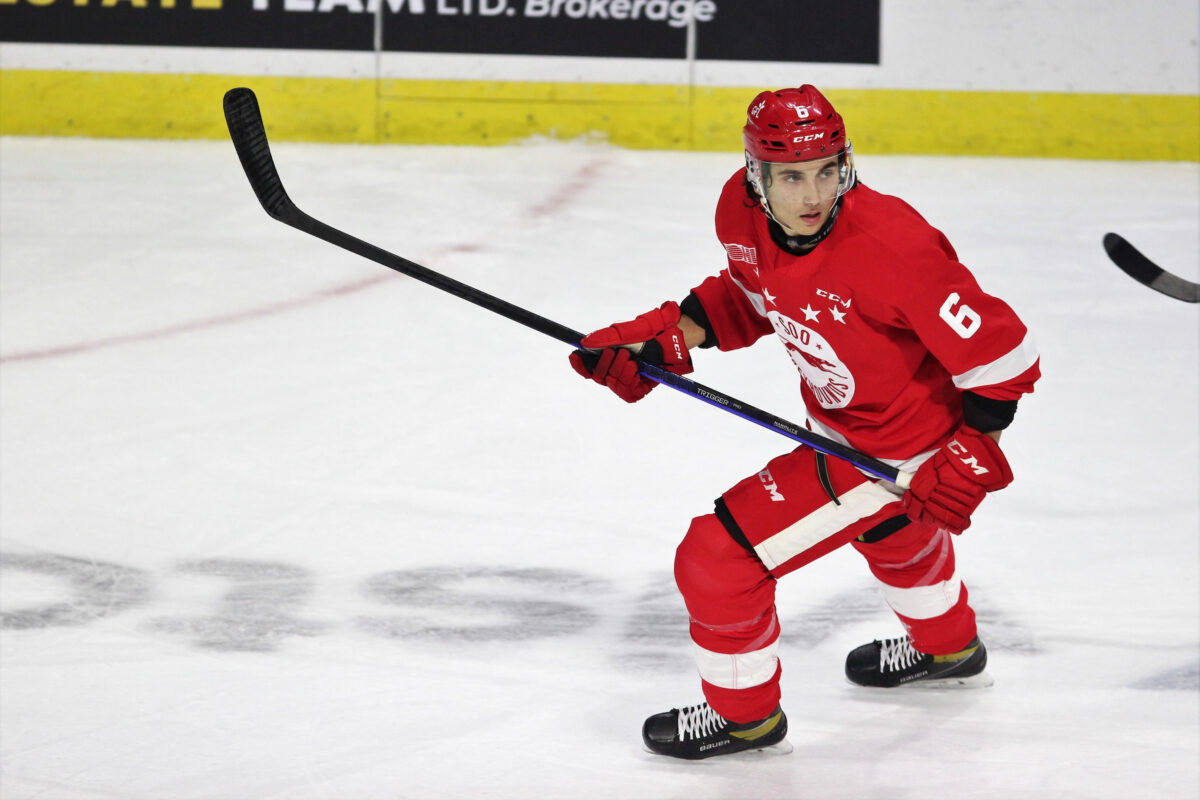The Detroit Red Wings entered the 2023 NHL Draft with 10 picks, including five through the first two rounds. There was much chatter heading into the draft about how Red Wings general manager Steve Yzerman would use those picks.
Would the Red Wings use one or more of their early picks to add talent to their current roster? All of that Alex DeBrincat chatter was leading to this, right? Would they package some of those picks to move up and take a run at Matvei Michkov or another prospect?
Once the final pick was made and the draft was complete, the Red Wings departed Nashville with 11 new prospects after they made one deal to move back in the second round, adding a fifth rounder in the process. No earth-shattering trades. DeBrincat is still an Ottawa Senator.
Related: 2023 NHL Draft Guide
But at the end of the day, this event is not about the deals that do or don’t get done on the draft floor. It’s about the young men that take the next big step in their hockey careers. It is also about what those young men mean to the franchises that select them. Ask a Columbus Blue Jackets fan how they’re feeling about their team’s selection at third overall and some of them will tell you that Wednesday was turning point in that franchise’s history.
The Red Wings, a team whose history includes 11 Stanley Cups, are still trying to return to the playoffs and become a perennial threat in the Eastern Conference. Their rebuild is in its seventh offseason. Over that time, Yzerman and his scouting staff, led by Kris Draper, have assembled what is widely considered to be one of the deepest prospect pools in the NHL. By adding 11 more prospects to it, they’ve added a degree of depth that few teams obtain even at the peak of their rebuild.
That being said, there is an argument to be made that depth isn’t what the Red Wings need right now. They need legitimate star power – quality over quantity. While there were some picks that offer hope on that end, it is also fair to suggest that Detroit made some questionable picks in this draft, especially in the early rounds.
Red Wings Add Danielson & Sandin Pellikka
The debate started right away as Yzerman stood up fairly quickly once it was time to make the ninth pick. With players like Zach Benson, Dalibor Dvorský and Matthew Wood still on the board, Yzerman called Brandon Wheat Kings center Nate Danielson’s name from the draft stage. For the second year in a row, the Red Wings used their first pick on a two-way centerman.
Related: Red Wings Draft Targets: Axel Sandin Pellikka
Much like the center the Red Wings picked in the 2022 draft, Marco Kasper, Danielson is a high-effort centerman that competes well and plays a north-south brand of hockey. Danielson is an adept playmaker that facilitated much of what the Wheat Kings were able to do this season, registering 78 points in 68 games with a team that finished with just 26 wins. He was also a co-captain of the team along with forward Nolan Ritchie. Danielson’s hard-working, underrated skill profile is similar to the profile that Kasper entered last year’s draft with.
“I think so,” Draper answered when asked if the two center prospects were similar. “One of the things that was interesting for us was Connor Bedard talking about, in the west, Nate Danielson was one of the toughest players to play against.”
That reflects the type of prospects that the Red Wings have prioritized in the draft since Yzerman’s first draft in 2019. If they can’t rely on lottery luck to deliver them a generational talent like Bedard, then they have to find ways to neutralize those players when their opponents have them. The Red Wings’ captain, Dylan Larkin, relishes the opportunity to go up against the Connor McDavids of the world, and that mentality is what Yzerman and Draper seem to be targeting as they build out the team’s center core of the future.

From that standpoint, the pick is a win. Danielson is also right-handed, and skilled, right-handed centermen can be hard to come by. He was a leader for his team on and off the ice, and that fits the character profile of prospects that Yzerman and Draper have been eager to add.
But despite all of that, it still feels like a pick where the Red Wings are just trying to get on base when they should be trying to swing for the fences – which is kind of funny, because the player they landed at 17th overall was a player that some were suggesting the Red Wings take a swing on at ninth overall.
At 17th overall, the Red Wings addressed perhaps the largest hole in their prospect pool by adding right-handed defenseman Axel Sandin Pellikka. When the Red Wings acquired this pick, they did so by trading defender Filip Hronek to the Vancouver Canucks. While Hronek had his shortcomings in the defensive end, he was a consistent offensive producer and he offered value as a young, right-handed defenseman that could play in the top-four. Removing him from the lineup left a noticeable hole in the Red Wings lineup, especially in terms of their balance of lefties and righties. That being said, if all goes well, the Red Wings will have found Hronek’s replacement, and then some, in Sandin Pellikka.
The Swedish defenseman is a smaller, offensive-minded defenseman that moves the puck exceedingly well. Between now and when he makes his NHL debut, you’ll hear all sorts of people say that he’s the future quarterback of the Red Wings’ power play – and for good reason. Sandin Pellikka brings a lot of creativity to the blue line, and he is arguably the best puck-mover in this draft class. With careful development, those people will be proven right; Sandin Pellikka has the potential to become the high-octane “modern-day defenseman” that the Red Wings’ lineup currently lacks.
“I think he’s a good offensive d-man,” Yzerman told media members. “a little bit different from what we have in our system, so we think that we was a good fit.”
To Yzerman’s point Sandin Pellikka stands out among the Red Wings’ defensive prospects not just because of his handedness, but because of his size as well. He is on the smaller side (5-foot-11, 181 pounds), making him an anomaly among Detroit’s crop of tall, rangy defenders, including a few that they added later in this draft.

But with the intrigue comes points of concern. If Sandin Pellikka’s offensive game, as lethal as it is, does not transfer to the NHL level, his defensive game is unremarkable and may not be enough to keep him afloat. There’s a reason he would have been a swing for the fences at ninth overall: his offensive talent gives him a high ceiling, but the bust factor looms large here if his development falls off the rails.
Given the amount of credible people in the scouting community that had Sandin Pellikka ranked within the top-15 (and sometimes even in the top-10), this pick feels more like a slam dunk for the Red Wings. He addressed a definite need in their system, and there’s a chance he becomes something special if he realizes his full potential. Oh, and he continued the Red Wings’ streak of drafting from the Swedish Hockey League in the first round, going back to 2020.
All in all, the Red Wings could have done a lot worse than leaving the first round with Danielson and Sandin Pellikka. Both players have legitimate NHL potential, and both could have a huge impact on the Red Wings’ future if they pan out. The real debate is whether or not you think the Red Wings could have done a lot better in the first round. Unfortunately, just like any other draft, we’ll have to wait a few years before we have any chance of being able to know the answer to that debate.
Notes On Red Wings’ Picks in Rounds 2-7
One of my favorite picks in this draft class is goaltender Trey Augustine at 41st overall, the team’s first pick in the second round. The Michigan-native is committed to play for Michigan State University this season, and he was often ranked as one of, if not the best goaltender available in this year’s draft. He was the third goaltender off the board after the Chicago Blackhawks and Arizona Coyotes took goalies early in the second round as well.
The reason this pick is so good (or so bad, depending on how you look at it) is because the Red Wings used a first round pick on a goaltender just two years ago when they selected Sebastian Cossa at 15th overall that year. Cossa spent the majority of this season in the ECHL with the Toledo Walleye and seems poised to challenge for a full-time spot with the Red Wings’ American Hockey League affiliate, the Grand Rapids Griffins, next season. After a couple years as the Red Wings’ “goaltender of the future”, that future is a bit more murky with Augustine (as well as sixth round pick Rudy Guimond) in the fold.
Augustine now represents competition for Cossa as he works his way up the pipeline. If Cossa doesn’t become the goaltender the Red Wings hope he will, there is another option in place – their eggs are not all in one basket anymore. Furthermore, if both goaltenders realize their potential, it gives the Red Wings one of the deepest goaltending depth charts to head into the future with.
Speaking of depth, the Red Wings added five defensemen (including Sandin Pellikka) to a pool that was already practically overflowing with defensive prospects. The group of new defenders includes three right-handed defensemen and two lefties. Looking more specifically at the two defensemen they added in the second round, it is clear that the Red Wings decided to bet on upside – but that upside comes in different forms.
Andrew Gibson, drafted 42nd overall, is an athletic, right-handed defenseman that stands at 6-foot-3, 202 pounds. He is a two-way defenseman that leans more on his offensive game to make an impact. He moves the puck well, and he is aggressive in the offensive zone in terms of puck pursuit and creating opportunities. That aggressiveness does come back to bite him sometimes, and his defensive game isn’t quite strong enough to compensate for it. If he can improve his decision-making with and without the puck, he could turn into a nifty middle-pairing option for the Red Wings down the road.

As for their second second round defender, Brady Cleveland is a monster on the ice that stands at 6-foot-5, 210 pounds. Offense isn’t his game. In fact, Cleveland is mostly known for the thunderous hits he can dish out. His overall competitive, physical nature gives him the potential to become an absolute menace on the blue line at the NHL level, but he’ll need to round out his game in other areas to reach that level. If you wanted the Red Wings to take a swing in this draft, they did here – just on physicality instead of skill.
Last but not least, there was a good story in the third round of the draft as the Red Wings took Noah Dower Nilsson with the 73rd pick. His brother, Liam, was a fifth round pick of the Red Wings back in 2021. Now the two brothers will develop together in the same system.
But make no mistake: Noah’s game is not comparable to his brother’s. Dower Nilsson is a shoot-first offensive player that some analysts had projected as a second round pick. He’s got good hands and can create shooting lanes for himself when he has possession. His defensive game is limited, so there’s a pretty good chance that he’s going to live or die as a prospect based on his offensive game. He projects to be a similar type of player as current Red Wing Dominik Kubalik: a middle six winger that can give you 20-25 goals a season based on his linemates and usage. Getting that type of player in the third round is good value in my books.
As for the rest of the Red Wings’ draft class, there is some promise there; Kevin Bicker, a fifth round pick, specifically looks like a player that could be a surprise in a few years based off of the habits he displays over in Germany. But the biggest takeaway from this group is that the Red Wings now have options and legitimate depth at almost every position. There are enough prospects on the verge of challenging for the NHL as well as long-term bets that the Red Wings should continue to see a steady stream of prospects pour into their lineup over the coming years. They could still use some firepower, but prospect quantity is absolutely not a problem in Hockeytown.
What Next?
Now that the 2023 draft is done, attention now pivots to the 2023 offseason and all the changes that could be on the horizon. They already added a couple players to their NHL roster, acquiring wingers Kailer Yamamoto and Klim Kostin from the Edmonton Oilers in exchange for future considerations. The Red Wings also hold extra picks in the first and fourth rounds of next year’s draft. Will they hold on to those picks and make those selections next year in Vegas, or will Yzerman finally pull the trigger on a deal that most expected to go down in Nashville?
With their 11 picks in this year’s draft, the Red Wings added a boatload of talent to their system, that much is undeniable. Yzerman stated that he intends to fill some of the holes in their roster in free agency, but there are no real stars available in this year’s free agency class. While everyone waits for a trade to happen, the focus internally has to be on the Red Wings’ prospects and young players. Can Kasper and/or Danielson become a top six center for this team in the near future? Can Sandin Pellikka and Simon Edvinsson elevate the skill level of the Red Wings’ offense? Have the Red Wings found their goaltender of the future?
All of this is to say that, despite the excitement provided by this year’s draft class, it is also the latest example that the Red Wings have a long way to go before they join the New Jersey Devils and Buffalo Sabres as the next big powerhouses in the NHL.